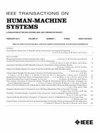Human-Like Trajectory Planning Based on Postural Synergistic Kernelized Movement Primitives for Robot-Assisted Rehabilitation
IF 3.5
3区 计算机科学
Q2 COMPUTER SCIENCE, ARTIFICIAL INTELLIGENCE
引用次数: 0
Abstract
The motor synergy pattern is an intrinsic characteristic found in natural human movements, particularly in the upper limb. It is essential to improve the multijoint coordination ability for stroke patients by integrating the synergy pattern into rehabilitation tasks and trajectory design. However, current robot-assisted rehabilitation systems tend to overlook the incorporation of a multijoint synergy model. This article proposes postural synergistic kernelized movement primitives (PSKMP) method for the human-like trajectory planning of robot-assisted upper limb rehabilitation. First, the demonstrated trajectory obtained from the motion capture system is subject to principal component analysis to extract postural synergies. Then, the PSKMP is proposed by kernelizing the postural synergistic subspaces with the kernel treatment to preserve human natural movement characteristics. Finally, the rehabilitation trajectory accord with human motion habits can be generated based on generalized postural synergistic subspaces. This approach has undergone practical validation on an upper limb rehabilitation robot, and the experimental results show that the proposed method enables the generation of human-like trajectories adapted to new task points, in accordance with the natural movement style of human. This method holds great significance in promoting the recovery of coordination ability of stroke patients.基于姿势协同核化运动原型的机器人辅助康复仿人轨迹规划
运动协同模式是人类自然运动,尤其是上肢运动的固有特征。将协同模式融入康复任务和运动轨迹设计中,对提高脑卒中患者的多关节协调能力至关重要。然而,目前的机器人辅助康复系统往往忽视了多关节协同模式的融入。本文提出了姿势协同核化运动基元(PSKMP)方法,用于机器人辅助上肢康复的类人轨迹规划。首先,对运动捕捉系统获得的演示轨迹进行主成分分析,以提取姿势协同作用。然后,通过核处理对姿势协同子空间进行核化,提出 PSKMP,以保留人类的自然运动特征。最后,根据广义姿势协同子空间生成符合人体运动习惯的康复轨迹。该方法在上肢康复机器人上进行了实际验证,实验结果表明,所提出的方法能根据人类的自然运动方式生成适应新任务点的类人轨迹。该方法对促进中风患者协调能力的恢复具有重要意义。
本文章由计算机程序翻译,如有差异,请以英文原文为准。
求助全文
约1分钟内获得全文
求助全文
来源期刊

IEEE Transactions on Human-Machine Systems
COMPUTER SCIENCE, ARTIFICIAL INTELLIGENCE-COMPUTER SCIENCE, CYBERNETICS
CiteScore
7.10
自引率
11.10%
发文量
136
期刊介绍:
The scope of the IEEE Transactions on Human-Machine Systems includes the fields of human machine systems. It covers human systems and human organizational interactions including cognitive ergonomics, system test and evaluation, and human information processing concerns in systems and organizations.
 求助内容:
求助内容: 应助结果提醒方式:
应助结果提醒方式:


